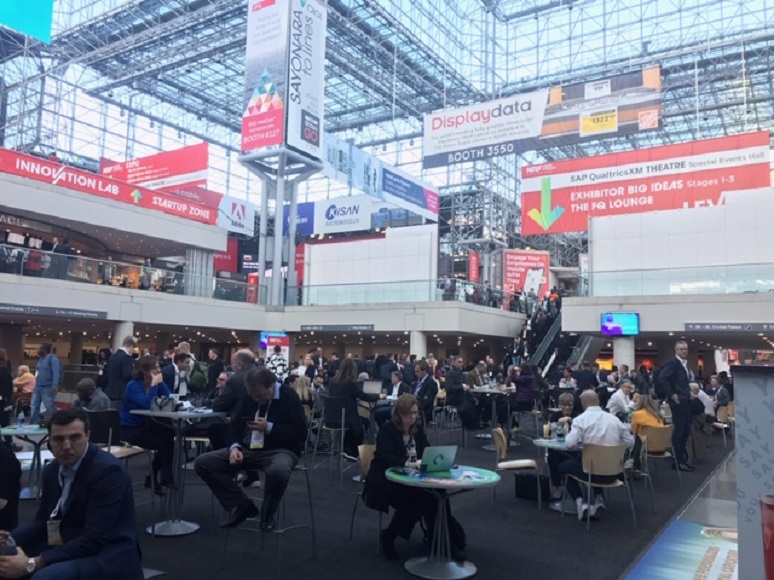Retailers faced a number of existential challenges throughout the 2010s, driven by increased competition from online giants, direct-to-consumer players, and “anything engines” like Amazon. Last week, 38,000 retailers, vendors, and industry experts gathered in New York City at the largest retail event in North America to explore solutions and strategies to remain competitive as they enter the next decade.
NRF 2020: Retail’s Big Show, organized annually by the National Retail Federation, brought together attendees from 100 different countries and featured a star-studded speaker line-up that included executives from leading retail brands like Lowes, Macy’s, and Best Buy. Customer experience and engagement, workforce management, and AI and voice-powered experiences are among the major themes and trends showcased throughout the conference sessions, keynotes, and exhibition booths. Read on for more on those and more.
Optimizing Customer Experience Across a Network of Stores
In order to future proof their brands, many traditional retailers must begin, or continue, to make smart, customer-centric updates to their existing technology systems. Emerging technologies like in-store mobile engagement and augmented reality are exciting — but they will only be available to retailers that have a strong infrastructure in place.
That's why providers like AT&T, Cisco, 8x8, and Verizon used NRF as an opportunity to showcase solutions that can help large retailers unify their legacy voice and messaging platforms. These solutions enable businesses with hundreds or thousands of stores to optimize inbound and outbound customer communications though cloud-based services. By unifying disparate systems, retailers can reduce costs, simplify management, and ensure that customer requests are routed to the appropriate local store or department. Retailers can then use this unified system to automate self-service across their network of stores, offering either centralized management by the retailer’s IT department or delegated management by local stores.
Strategies to Improve Workforce Efficiency and Speed to Market
Hitha Herzog, chief research officer at H Squared Research, said it best during her conversation with Rent the Runway CEO Jennifer Hyman: "Speed to market is so crucial when it comes to customer experience. Customers want things faster, better, more accessible."
Executing on innovation, and doing so faster than your competitors, was a major theme at NRF2020. During a session entitled "Living in an Amazon World: New Rules," WD Partners Executive Vice President Lee Peterson stressed the importance of organizing around the consumer and bringing together new teams focused on specific services — Buy Online, Pick up in Store (BOPIS), Showroom, Self-Checkout — instead of verticals (HR, Marketing, Merchandising, etc.).
Solutions for optimizing workforce efficiency and productivity on the expo floor included intelligent workforce management platforms that enable large retailers to maximize efficiencies for staffing, and technology to automate shift filling and scheduling. There were also a wide variety of automation solutions — from robots roaming store aisles to check inventory and cleanliness to retailers like
Pizza Hut that use virtual sales agents to answer questions, take orders, and route calls to local stores.
AI and Voice-Powered Experiences Are Changing Retail
It was no surprise to see AI featured prominently on the session agenda and in bold type across exhibitor banners throughout the expo center. The use cases for AI were countless at NRF and touched every area of the retail value chain. In 2020, retailers are, and will be, using AI to make real-time improvements to order fulfillment, process automation, workforce management, supply chain optimization, and customer interactions.
Another prominent trend around customer interactions was the use of voice to transform the shopping experience. Amazon, Google, IBM, and other vendors featured solutions that enable retail customers to ask questions, self-educate, and make purchases via voice platforms. And retailers can count on this trend to continue. According to the Amazon Pay Connected Commerce Survey, conducted in April 2019 and referenced during an NRF session on voice, 20% of U.S. customers are likely to make a purchase using voice in the next three years. That survey also found that 30% of consumers ranked the ability to make purchases "in the moment" as one of the top five reasons to purchase through the voice channel. Session leaders suggested that, as a result, retail experiences may be moving from customer journeys to customer moments.
The Competitive Advantage of Brick-and-Mortar Stores
From immersive in-store experiences to leveraging physical store space for faster fulfillment, NRF demonstrated that storefronts will continue to play an important role in delighting retail customers and building brand loyalty. For example, the expo floor featured many solutions for delivering BOPIS, a fulfillment channel that is enabling traditional retailers to get online orders in customers’ hands faster, save them money on shipping and connect with them in-store.
Stein Mart announced its BOPIS solution, which features a "smart button" that customers can push when arriving at a store. It uses an Amazon IoT device to communicate with a
virtual agent that triggers an overhead page, alerting store associates to welcome the customer and ensure a delightful pickup.
Research from strategy and insights firm WD Partners finds that BOPIS currently ranks No. 1 in terms of the “technologies” that influence consumers to make a purchase. According to the firm, not every BOPIS model will be the same for every retailer, but BOPIS solutions must always deliver "increased new shopper acquisition and conversation; retention and additional shopping occasions among existing shoppers; and an efficient and actionable operational model."
Optimizing Online and In-Store Engagement
The integration of physical and digital retail experiences has become crucial to success for today's retailers. As Erik Nordstrom, co-president of Nordstrom, said during his keynote conversation with NBC News' Jo Ling Kent: "I’ve yet to have a customer use the word ‘channel’ with me… Those lines are completely blurred.” Nordstrom went on to add that more than half of his sales have an online component and more than a third of online sales involve an in-store experience.
Optimizing online-in-store engagement could include installing a bar in the shoe area of your flagship store, like Nordstrom; using location-based technology to send relevant promotions to customers who are walking by; leveraging data gathered from the shopper’s online behavior to enhance their in-store shopping experiences; or implementing technology that uses 3D imaging to better fit clothes.
These observations represent only a small sampling of the innovation and the discussions taking place in retail right now. However, one thing remains clear: The retail industry is evolving rapidly by leveraging technology for service automation to remain competitive for the next decade.










